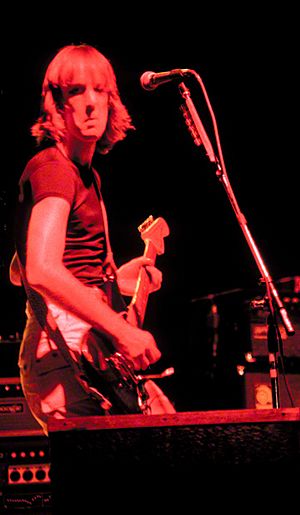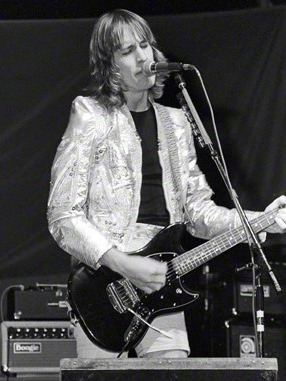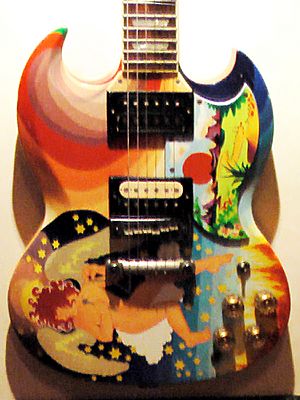Todd Rundgren facts for kids
Quick facts for kids
Todd Rundgren
|
|
|---|---|
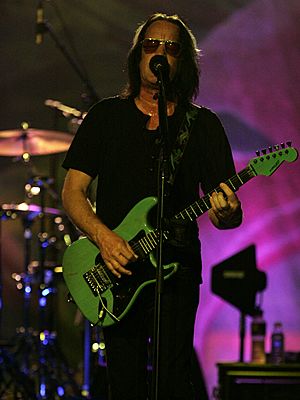
Rundgren performing in 2013
|
|
| Background information | |
| Birth name | Todd Harry Rundgren |
| Born | June 22, 1948 Philadelphia, Pennsylvania, U.S. |
| Genres |
|
| Occupation(s) |
|
| Instruments |
|
| Years active | 1966–present |
| Labels |
|
| Children | Liv Tyler (adoptive/legal daughter) |
Todd Harry Rundgren (born June 22, 1948) is an American musician, singer, and songwriter. He is also a talented record producer, someone who helps artists make their music sound great. Todd has explored many different music styles throughout his career. He has performed as a solo artist and was part of the bands Nazz and Utopia.
Todd is known for his unique and sometimes unusual music. His stage shows were often very grand and exciting. Later in his career, he experimented with interactive art, where the audience could be part of the experience. He also produced music videos and was one of the first to use new computer technologies. For example, he used the internet to share music in the late 1990s.
Todd started his music journey in the mid-1960s in Philadelphia. In 1967, he formed the psychedelic band Nazz. After two years, he left Nazz to start his solo career. His first big hit was "We Gotta Get You a Woman" in 1970. Some of his most famous songs include "Hello It's Me" and "I Saw the Light" from his 1972 album Something/Anything?. You can still hear these songs on classic rock radio. Other popular songs are "Can We Still Be Friends" (1978) and "Bang the Drum All Day" (1983). "Bang the Drum All Day" is often played at sports events, in commercials, and movie trailers.
Todd Rundgren is seen as a pioneer in many areas. He was one of the first to explore electronic music, progressive rock, and music videos. He also made early advances in computer software and delivering music online. In 1978, he organized the first interactive television concert. He designed an early color graphics tablet in 1980. He also created what was called the first interactive album, No World Order, in 1994. He was one of the first artists to be famous both as a musician and a producer. He produced albums for many well-known bands, including Meat Loaf's Bat Out of Hell (1977). Todd was honored for his contributions to music when he was inducted into the Rock and Roll Hall of Fame in 2021.
Contents
- Todd Rundgren's Early Music Journey
- Todd Rundgren Becomes a Producer
- Todd Rundgren's Solo Career Begins
- Early Solo Albums: Runt and Ballad of Todd Rundgren
- Something/Anything? and Big Hits
- New Directions: A Wizard, a True Star, Todd, and Utopia
- Later 1970s: Initiation, Faithful, and Hermit of Mink Hollow
- 1980s–1990s: A Cappella and Live Recordings
- 1990s–2000s: Interactive Music and PatroNet
- 2000s–2010s: New Bands and Collaborations
- 2020s: Recent Work
- Todd Rundgren's Music Style and Impact
- Todd Rundgren's Family Life
- Awards and Honors
- Todd Rundgren's Music Albums
- See also
Todd Rundgren's Early Music Journey
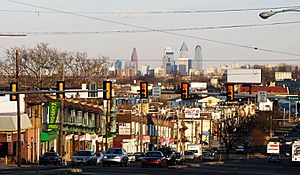
Todd Harry Rundgren was born in Philadelphia on June 22, 1948. He grew up in a nearby town called Upper Darby Township, Pennsylvania. He taught himself how to play the guitar. As a child, Todd loved his parents' small record collection. It had show tunes and symphonic music. He especially liked the operettas by Gilbert and Sullivan. Later, he became a big fan of the Beatles, the Rolling Stones, and the Yardbirds. He also liked the Philadelphia soul music of artists like Gamble & Huff. When he was 17, he started his first band called Money.
After finishing high school in 1966, Todd moved to Philadelphia. He joined a blues rock band called Woody's Truck Stop. He stayed with them for eight months. The band became very popular in Philadelphia. Todd and bassist Carson Van Osten left to form the rock band Nazz in 1967. Todd was no longer interested in blues music. He wanted to create original songs like those by the Beatles and the Who. In Nazz, he learned how to write songs and arrange vocals. He wanted his music to be as artistic as the Beatles'.
In 1968, Nazz signed with Atlantic Records. They recorded their first album in Los Angeles. Todd had no experience producing music. He decided to experiment with the recordings. He used techniques like varispeed and flanging. He also scored music for string and horn parts without formal training. Nazz gained some attention with their first single, "Open My Eyes," in July 1968. The other side of the single was "Hello It's Me," both written by Todd.
Nazz released three albums: Nazz (1968), Nazz Nazz (1969), and Nazz III (1971). Todd's music tastes began to change. He started composing more on the piano. The other band members found it hard to keep up with his new ideas. Todd started taking full control of the recording sessions as the producer. This caused some tension in the band. By the time Nazz Nazz was released, Todd and Carson Van Osten had left Nazz. Nazz III was released later without Todd's involvement.
Todd Rundgren Becomes a Producer
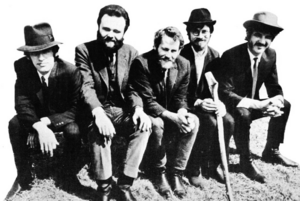
After leaving Nazz, 21-year-old Todd thought about becoming a computer programmer. But he soon decided his true calling was to be a music producer. In the summer of 1969, he moved to New York. He spent time in clubs in Greenwich Village and met many musicians. Michael Friedman, who used to work for Nazz's manager, offered Todd a job. He became a staff engineer and producer for Albert Grossman. Grossman had just started Ampex Records and built Bearsville Studios. Todd accepted the job. Grossman told him he would become the "highest-paid producer in the world," which later came true.
Todd started by working with older folk artists. Soon, he became Bearsville's main engineer. He traveled to Canada to record Jesse Winchester's first album in 1970. After that, the Band asked him to engineer their Stage Fright album. This album was very successful, reaching number 5 on the Billboard 200 chart. Todd was then called Bearsville's "boy wonder."
He continued to produce albums for other artists. He worked on a second album for Jesse Winchester. He also produced Taking Care of Business for the James Cotton Blues Band. Through this project, he met keyboard players Mark "Moogy" Klingman and Ralph Schuckett. They would work with Todd many times in the future.
Todd Rundgren's Solo Career Begins
Early Solo Albums: Runt and Ballad of Todd Rundgren
Todd decided he wanted to perform again. He talked to Albert Grossman about making his first solo record, Runt. Todd wanted to make the music he liked and hoped the record label would promote it. He didn't ask for a big advance payment. He just asked for money to cover the studio costs.
Runt was released in mid-1970. It was not originally credited to Todd Rundgren himself. Instead, it was released under the name "Runt." The album had a bright sound. It included songs inspired by Laura Nyro. Todd recorded it with young brothers Tony Fox Sales (bass) and Hunt Sales (drums). The lead single, "We Gotta Get You a Woman," became a Top 20 hit. As he worked on his next album, Todd produced the debut album for a band called Halfnelson. This band later became Sparks. The members of Sparks later said Todd helped launch their career.
Todd's reputation in the music industry grew after Runt was successful. His second album, Runt. The Ballad of Todd Rundgren, came out in June 1971. It mostly featured piano ballads. It had two singles, "Be Nice to Me" and "A Long Time, a Long Way To Go." These songs did not repeat the success of "We Gotta Get You a Woman." While early reviews were mixed, Ballad is now seen as one of the best singer-songwriter albums of that time.
Something/Anything? and Big Hits
In late 1971, Todd was asked to finish Badfinger's third album, Straight Up. George Harrison had started the project but left to organize the Concert for Bangladesh. Straight Up was a hit album with successful singles. Todd then returned to Los Angeles to work on his third solo album. He originally planned it as a single album.
Something/Anything? was the first album officially released under Todd Rundgren's name. It came out in February 1972. This album included many of his most famous songs. It had straightforward pop songs, but also longer musical jams and studio talk. The album reached number 29 on the Billboard 200 chart. It was certified gold in three years, meaning it sold over 500,000 copies. The lead single, "I Saw the Light," reached number 16 on the Billboard Hot 100. "Hello It's Me" followed in late 1973 and reached number 5.
Music critics now consider Something/Anything? a landmark album of the early 1970s. The song "Couldn't I Just Tell You" was very important for artists in the power pop music style. In 2003, Rolling Stone magazine ranked Something/Anything? as one of the "500 Greatest Albums of All Time."
New Directions: A Wizard, a True Star, Todd, and Utopia

Todd's next albums, starting with A Wizard, a True Star, showed a big change in his music. He also formed a new group called Utopia. His music started to sound more like progressive rock artists such as Frank Zappa and Yes. Other influences on his album included musical theater, jazz, and funk.
A Wizard, a True Star was released in March 1973. Todd asked that no singles be released from the album. He wanted people to hear all the songs together as a complete album. Its release happened at the same time as the success of "Hello It's Me." This gave Todd a reputation as a ballad singer, which was different from the music on Wizard. Critics had mixed reactions to the album. However, Wizard became very influential for musicians in later years. Many artists today still show the influence of Wizard in their music.
After releasing Wizard, Todd produced two very important albums in 1973. These were Grand Funk Railroad's We're an American Band and the New York Dolls' self-titled debut album. We're an American Band reached number two on the US charts. The New York Dolls' album became a key album for punk rock. Todd also put together a technologically advanced stage show with a band that would become Utopia Mark I. This tour started in April but was canceled after only a few weeks.
Todd then focused on creating an improved version of Utopia. But first, he recorded a double album called Todd. This album used more synthesizers. During the making of Todd, Todd noticed the musical connection between session musicians Kevin Ellman (drums) and John Siegler (bass). He chose them, along with Klingman and keyboardist Ralph Shuckett, to be the new Utopia lineup. This new Utopia played their first show in Central Park on August 25, 1973.
Utopia went on their first successful tour in March and April 1974. After that, Todd produced albums for Hello People and Hall & Oates. The band's first album, Todd Rundgren's Utopia, was released in November 1974. This album was Todd's first full step into the progressive rock style. Utopia released several more albums between 1975 and 1985. They slowly changed their sound to be more rock-pop. However, Todd Rundgren's Utopia remained their highest-charting album.
Later 1970s: Initiation, Faithful, and Hermit of Mink Hollow
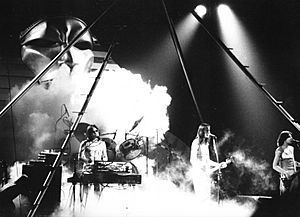

Initiation (1975) showed Todd experimenting more with synthesizers. It also showed the influence of jazz fusion music. The original album was very long, with one side lasting over 35 minutes.
Faithful, released in May 1976, celebrated Todd's ten years as a professional musician. One side of the album had his original songs. The other side had covers of famous songs from 1966. These included "Happenings Ten Years Time Ago" by the Yardbirds and "Good Vibrations" by the Beach Boys. Todd tried to make the covers sound very similar to the originals. His own songs on the album reflected his 1960s influences. He said the song "The Verb 'To Love'" made him decide to write about more than just love. Even though Faithful didn't sell much, "Good Vibrations" was played often on American radio.
After Faithful, Todd went on a two-month spiritual trip to places like India and Japan. He also opened Utopia Sound Studios in Lake Hill, New York. This studio and a nearby home became Todd's base for the next six years. Before his next solo album, he recorded three albums with Utopia. One was Disco Jets, a collection of instrumental disco tracks. Ra (February 1977) was a concept album about Egyptian mythology. This led to a big tour with a huge pyramid and Sphynx head on stage. Oops! Wrong Planet (September 1977) showed Utopia moving towards a more pop-oriented sound.
By late 1977, Todd was going through a personal change. He moved to Mink Hollow. He wanted his next solo album to be mostly piano songs with simple arrangements. Hermit of Mink Hollow was released in May 1978. Many people saw it as his most accessible work since Something/Anything?. It got more public attention and radio play than his progressive rock albums with Utopia. It was seen as a "return to form." In the US, the album reached number 36. The single "Can We Still Be Friends" reached number 29. This song became Todd's most covered song. Artists like Robert Palmer and Rod Stewart recorded their own versions. To promote the album, Todd toured smaller venues in America. These shows led to the live album Back to the Bars. It featured songs from his solo work and Utopia.
In 1980, Utopia released Deface the Music, an album that made fun of the Beatles.
1980s–1990s: A Cappella and Live Recordings
Todd Rundgren signed with Warner Bros. Records. They released his next album, A Cappella (1985). This album was unique because Todd recorded it using only his multi-tracked voice. All the music was made from programmed vocal sounds. In 1986, Todd also wrote music for four episodes of the children's TV show Pee-wee's Playhouse.
Nearly Human (1989) and 2nd Wind (1991) were both recorded live. Nearly Human was recorded in the studio, and 2nd Wind was recorded in a theater with a quiet audience. Each song on these albums was recorded in one complete take. There were no extra recordings added later. Both albums marked a return to his Philadelphia soul music roots. 2nd Wind also included songs from Todd's musical Up Against It.
Todd was an early user of the NewTek Video Toaster. He made several videos with it. The first, for "Change Myself" from 2nd Wind, was used to show what the Toaster could do. Later, he started a company to make 3D animation using the Toaster.
In 1989, Todd toured with the Nearly Human—2nd Wind band. This band included brass instruments and three backup singers. One of the backup singers, Michele Gray, later married Todd. He also toured in 1992 with Ringo Starr's second All-Starr band. A short tour of Japan in 1992 reunited Todd with some of his Utopia bandmates. A live album from this tour, Redux '92: Live in Japan, was released.
1990s–2000s: Interactive Music and PatroNet
In the mid-1990s, Todd Rundgren recorded music under the name TR-i, which stood for "Todd Rundgren interactive." His first album as TR-i was 1993's No World Order. This album had hundreds of short music clips. Listeners could combine these clips in different ways. It was designed for the Philips CD-i platform. No World Order let users control the tempo, mood, and other parts of the music. It also had pre-made mixes by Todd and other producers. The music on this album was very different from his earlier work. It had a dance and techno feel, with Todd rapping. The next album, The Individualist (1995), had interactive video content. It even included a simple video game along with the music. This album was more rock-oriented.
Todd returned to recording under his own name for With a Twist... (1997). This album featured bossa-nova versions of his older songs. His PatroNet project, where he shared music with subscribers, was released as One Long Year in 2000. In 2004, Todd released Liars. This was a concept album about "the lack of truth." It mixed his older and newer sounds.
As the internet became more popular, Todd started PatroNet with his manager. This allowed fans (called patrons) to access his new music and works-in-progress. They paid a subscription fee, which meant Todd didn't need record labels. The songs from PatroNet were later released as the album One Long Year. Since then, Todd has worked independently from major record labels. He continues to offer new music directly to his fans through his website. He also releases CDs through independent labels.
2000s–2010s: New Bands and Collaborations
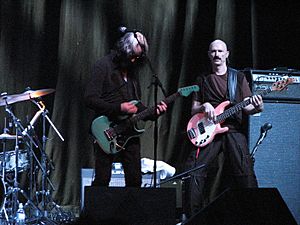
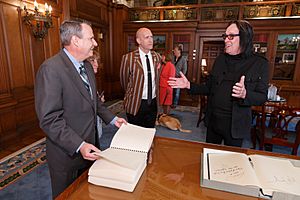
After the September 11 attacks, Todd created music for the film A Face to a Name. The film showed photos of missing New Yorkers. It was part of a special screening at the Woodstock Film Festival in 2002.
In late 2005, the band the Cars planned to reunite. Todd joined Elliot Easton and Greg Hawkes in rehearsals. The new lineup was called The New Cars. It included former Rundgren bassist Kasim Sulton and drummer Prairie Prince. In early 2006, The New Cars played some private shows. They also appeared on The Tonight Show with Jay Leno. They then went on a summer tour with Blondie. Todd said this project was a chance to "pay my bills, play to a larger audience, work with musicians I know and like, and ideally have some fun." The New Cars released their first single, "Not Tonight," in March 2006. A live album, The New Cars: It's Alive, came out in June 2006. It had classic Cars songs, two of Todd's hits, and three new studio tracks.
In April 2011, Todd Rundgren's Johnson was released. It was a collection of Robert Johnson cover songs. Another album of covers, (re)Production, came out in 2011. On this album, Todd performed songs he had previously produced for other artists. These included "Walk Like a Man" by Grand Funk Railroad.
In 2017, Todd released White Knight. This album featured collaborations with many artists. These included Trent Reznor, Robyn, Daryl Hall, Joe Walsh, and Donald Fagen.
In December 2018, Todd published his memoir, The Individualist: Digressions, Dreams, and Dissertations. The book has 181 chapters, each one page long. Todd said he realized he had to write it himself. The book covers his life up to his 50th birthday in 1998. On October 21, 2019, he visited the Library of Congress. He signed a braille copy of his book, which was made by a fan.
Todd toured in late 2019 with other musicians. They celebrated the Beatles' 1968 album on the "It Was Fifty Years Ago Today – A Tribute to the Beatles' White Album" tour.
2020s: Recent Work
In 2020, Todd worked with Weezer frontman Rivers Cuomo. They released the single "Down With The Ship." In December, he released his English translation of the 1978 song "Flappie." In April 2020, he reunited with Sparks 50 years after producing their first album. They released a single called "Your Fandango." In September 2022, he released the album Space Force.
He also provided extra vocals on the song "My Soul" by the hip hop duo ¥$. This song is from their album Vultures 2, released in August 2024.
Todd Rundgren's Music Style and Impact
As a Solo Artist
Music critic Stephen Thomas Erlewine describes Todd Rundgren as a talented pop musician. His most famous songs like "I Saw the Light" and "Hello, It's Me" show this. But at his heart, Todd is a "rock & roll maverick." After finding success with Something/Anything? in 1972, Todd decided to move away from mainstream pop music. He explored new musical areas. He became a pioneer in electronic music, progressive rock, music videos, and computer software. He also pioneered internet music delivery.
As a solo artist from 1972 to 1978, Todd had four songs reach the Top 40 on the Billboard Hot 100 chart. "Hello, It's Me" was a Top 10 hit. He also had three albums in the Top 40 on the Billboard 200. He is one of the first artists to be famous both as a musician and as a producer. He also influenced music styles like power pop and lo-fi. Todd was an early adopter of digital technology in music. He said he went digital as soon as the technology became affordable. He also mentioned that he didn't worry about making music that would sell well. This was because he earned a lot of money from his production work.
As a Producer
Todd Rundgren is sometimes compared to other famous producer/artists like Brian Wilson and Brian Eno. Biographer Paul Myers says that the recording studio is Todd's "ultimate instrument." Todd himself said that when he makes his own records, he doesn't think like a "producer." Instead, he uses the studio to help create a performance. His recording methods followed the traditions of early recording innovators like Les Paul. They also built on the studio experiments of the Beatles and the Beach Boys.
According to Myers, Todd Rundgren inspired "a generation of self-contained geniuses like Prince." His new ideas helped artists become more independent. This sometimes made the role of a record producer less necessary. Todd's influence is also seen in artists like Hall & Oates, Björk, and Daft Punk.
Todd's production work for other artists was usually for one album at a time. Some exceptions were Grand Funk Railroad and the New York Dolls. He described his job as a producer as being a "'songcraft' agitator." This means he pushed artists to make their songs better.
The Fool Guitar
In the mid-to-late 1970s, Todd often played a very noticeable psychedelic Gibson SG guitar. This guitar was known as "Sunny" or "The Fool." Eric Clapton had played it in his band Cream. After Clapton stopped using it around 1968, he gave it to George Harrison. Harrison then loaned it to British singer Jackie Lomax. In 1972, Lomax sold the guitar to Todd for $500.
Todd played The Fool guitar a lot during the early years of Utopia. He stopped using it for a short time in the mid-to-late 1970s. During that time, the guitar was restored. It got a lacquer finish to protect the paint. The tailpiece and bridge were also replaced to help with tuning. Todd brought the guitar back on tour in 1980. He used it on and off throughout the 1980s until 1993. He then permanently stopped using it. He eventually sold the guitar at an auction in 1999. Today, he uses a copy of the guitar that a Japanese fan gave him in 1988.
Todd Rundgren's Family Life
Todd Rundgren started a relationship with model Bebe Buell in 1972. Bebe Buell gave birth to Liv Tyler on July 1, 1977. Todd remained a committed father figure to Liv. Liv learned that her biological father was Steven Tyler when she was eleven. As of 2012, Liv Tyler has a close relationship with Todd. She said, "I'm so grateful to him, I have so much love for him. You know, when he holds me it feels like Daddy. And he's very protective and strong."
Todd had a long-term relationship with Karen Darvin. They had two sons, Rex (born 1980) and Randy (born 1985). Rex was a minor league baseball player for nine seasons.
Todd married Michele Gray in 1998. Michele had been a dancer and a backup singer for Todd's Nearly Human tour. They have a son named Rebop and an adopted son named Keoni.
Awards and Honors
- 1984: Grammy Award nomination for Best Music Video – "Videosyncracy"
- 1995: Berkeley Lifetime Achievement Award from the Popular Culture Society at UC Berkeley.
- 2017: Honorary doctorate from Berklee College of Music. He also gave the commencement speech there. He also received an honorary doctorate from DePauw University.
- 2018: Nominated for the Rock and Roll Hall of Fame's class of 2019.
- 2021: Inducted into the Rock and Roll Hall of Fame.
Todd Rundgren's Music Albums
Solo albums
- Runt (1970)
- Runt. The Ballad of Todd Rundgren (1971)
- Something/Anything? (1972)
- A Wizard, a True Star (1973)
- Todd (1974)
- Initiation (1975)
- Faithful (1976)
- Hermit of Mink Hollow (1978)
- Healing (1981)
- The Ever Popular Tortured Artist Effect (1982)
- A Cappella (1985)
- Nearly Human (1989)
- 2nd Wind (1991)
- No World Order (1993) (as TR-I)
- The Individualist (1995) (as TR-I)
- With a Twist... (1997) (remakes album)
- One Long Year (2000)
- Liars (2004)
- Arena (2008)
- Todd Rundgren's Johnson (2011) (covers album)
- (re)Production (2011) (covers album)
- State (2013)
- Global (2015)
- White Knight (2017)
- Space Force (2022)
Nazz
- Nazz (1968)
- Nazz Nazz (1969)
- Nazz III (1971)
Utopia
- Todd Rundgren's Utopia (1974)
- Another Live (1975)
- Ra (1977)
- Oops! Wrong Planet (1977)
- Adventures in Utopia (1979)
- Deface the Music (1980)
- Swing to the Right (1982)
- Utopia (1982)
- Oblivion (1984)
- POV (1985)
Other albums
- Up Against It! (1997)
(1980s demos for the musical of the same name) - Somewhere/Anywhere (1998)
(Japanese-imported compilation of unreleased tracks) - Disco Jets (2001)
(Utopia album recorded 1976) - It's Alive! (2006)
(The New Cars) - Runddans (2015) (with Lindstrøm and Emil Nikolaisen)
See also
 In Spanish: Todd Rundgren para niños
In Spanish: Todd Rundgren para niños


